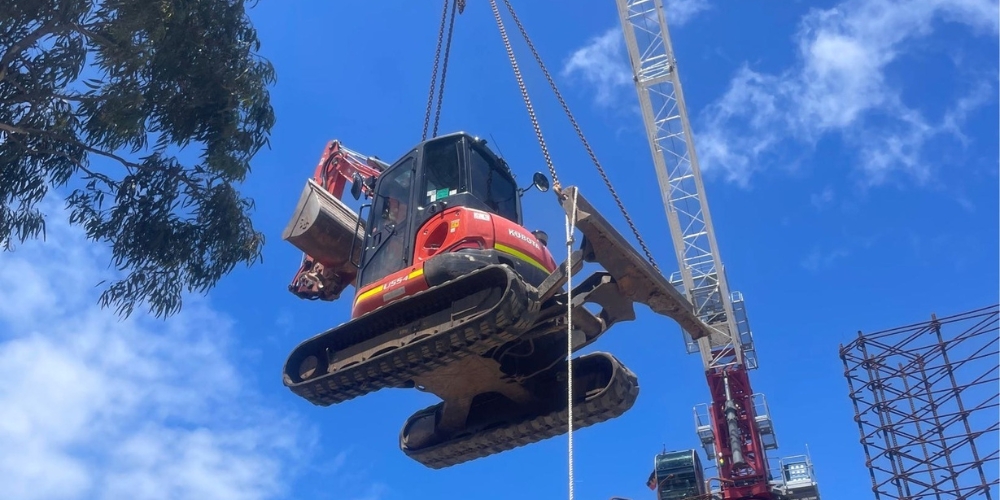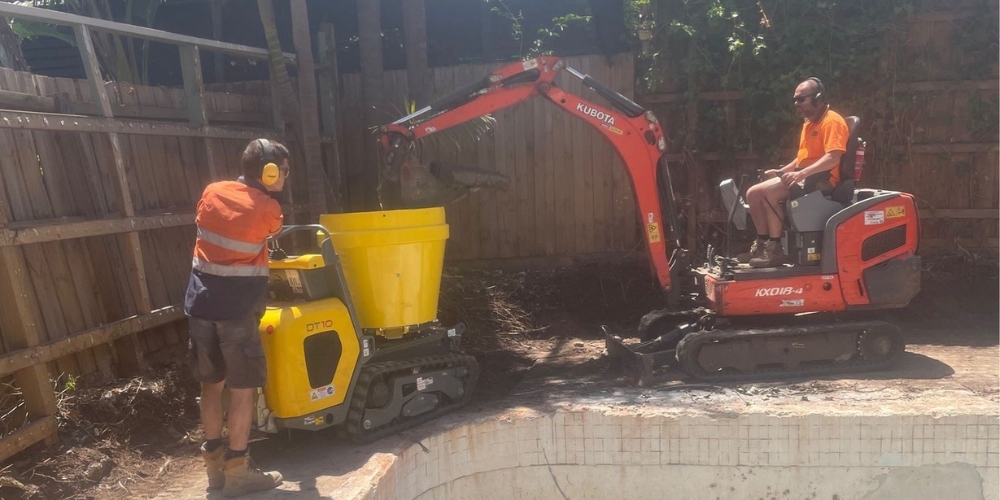Table of Contents
Safety Tips Around Excavators
Excavators are used on a wide range of jobs, including construction and demolition sites, road construction, agricultural and forestry work, mining, and more. Digging is, of course, the most common of their numerous applications. As a result, in addition to these excavator safety tips, make sure you’re also familiar with trench safety.
All heavy equipment poses serious, if not fatal, risks to its operators and those nearby. The excavator’s boom, dipper, and bucket are particularly dangerous because of their quick and far-reaching motion. As they’re lifted, maneuvered, and dumped, bucket loads are as well. Excavators now have more built-in safety features than ever before, but that does not mean that anyone can climb into a cab and safely operate one.
When using an excavator, things like rocks, construction materials, and stumps can compromise safety. Before you start operating the machine, make sure these are removed from the area. Check the area for holes, ditches, and inclines that could cause problems once you start working.
If you’re working in a new area, check with the local utility district to see if any underground pipes or electrical lines can be marked. When excavators come into direct contact with live power lines, they become electrified, endangering the operator’s and others’ safety. When using an excavator, there are a few safety considerations to keep in mind.

Crucial Excavator Safety Tips
Inspection
It’s critical to keep this lifting device in good working order so that it can be used safely. It should also be thoroughly inspected and tested by the contractor prior to the operation to ensure that it is in good working order. Any deficiency should be reported so that corrective action can be taken.
Protective Equipment
Personal protective equipment (PPE) is important for operator safety. To make yourself more visible, put on a reflective vest and durable work boots to protect your feet. A hard hat and clear or tinted safety glasses are also recommended. In some cases, you’ll want to wear gloves and ear protection to protect your hands and ears.
Keep An Open Eye
When operating machinery on the job site, operators must be aware of their surroundings. In residential areas, there are numerous dangers such as overhead power lines, passing workers, and even oncoming traffic. All of these factors can make operating heavy construction equipment on any job site extremely difficult. Here are some pointers to help keep the environment safe for machine operators, other workers, and the general public.
- De-energize electrical lines to ensure that accidents do not cause damage to nearby homes or operators.
- Call the local utility company before digging to ensure that water, gas, and other utilities are turned off.
- To prevent other workers from entering the “danger zone,” clearly mark the area where heavy equipment will be used.
- Workers and pedestrians should be kept out of the area where the work is being done whenever possible.
Maintain Communication Channels
Heavy equipment operators must be 100% certain that the desired movement is safe to complete, whether backing up or adjusting position. The best way to avoid accidents is to use spotters, and each spotter should have a two-way radio to communicate with the operator throughout the day. If your team doesn’t have a two-way radio, they’ll have to communicate with each other using hand signals or signs.
To ensure that operators can see the team, all spotters should wear appropriate PPE, such as bright safety vests. Spotters should be in charge of redirecting pedestrians and oncoming traffic to ensure safety while heavy equipment is in operation, in addition to wearing the appropriate PPE such as safety vests and safety glasses.
Appropriate Attachment
Only use attachments that have been approved by the manufacturer, and make sure you’ve chosen the right style and shape for the job at hand. Heavy-duty buckets, for example, are ideal for a variety of soil types, including clay, gravel, sand, shale, and silt. In situations like severe digging or handling abrasive materials, heavy-duty buckets are the best choice.
Do not attempt to lift more than the machine is capable of. Before beginning a job, double-check the maximum load capacity. If you’re using an excavator, make sure you’re not trying to lift anything heavier than the machine was designed to lift. The operator manual for the machine will list the load capacities. Overloading the bucket can cause the excavator to tip over – keep in mind that as the bucket is raised, the lifting capacity decreases, so the capacity recommendations are there for a reason.

Make Sure To Wear A Seat Belt
An excavator only has one seat, which is for the operator. An excavator operator who lacks proper training and experience should not be in charge. Furthermore, the driver must wear a seat belt to ensure his or her comfort and safety. Even though an excavator does not move as quickly as a car, it is still necessary to wear a seat belt. If the machine overturns or collides with something, it helps to protect you.
Positioning the Blades
Proper blade positioning with your excavator is critical for balancing and safety. You’ll want to keep the blade in front of a mini excavator that weighs more than 8 tons. Positioning the blade in the back of smaller excavators, especially those weighing less than 3 tons, can provide much-needed stability and balance.
If you try to dig with the blade in the front of a smaller excavator, the cab will tip backward as the bucket digs into the soil. It’s best to move the blade to the back of the excavator in this case. It has the ability to grip the ground to provide stability and prevent the cab from tipping over while digging.
Create Buffer Zones
Construction sites are hazardous by nature, but they become even more so when they are near busy highways or areas with a high volume of pedestrian traffic. Often have a squad working to hold cars and people safe from large machinery in these cases.
In most cases, a physical barrier between heavy equipment and traffic will be necessary. This is frequently accomplished by using warning signs like road cones and physical barriers along highways. You’ll need to consult the DOT handbook on how to set up your buffer and caution zone to keep the job site safe.
Conclusion
These are just a few of the most important precautions to take when operating an excavator. Before using the excavator, ensure that all operators have received proper training and that all manufacturer guidelines are followed.
If you’ve worked in construction for any length of time, you’re well aware that heavy equipment is critical to completing large projects on time and on budget. However, operating heavy construction equipment can be difficult, and it can create dangerous situations on any job site. Ensure that a safety protocol is in place to keep operators, workers, and pedestrians safe while the machine is in operation. Keep your construction project moving forward by following the 8 heavy equipment safety tips listed above!
